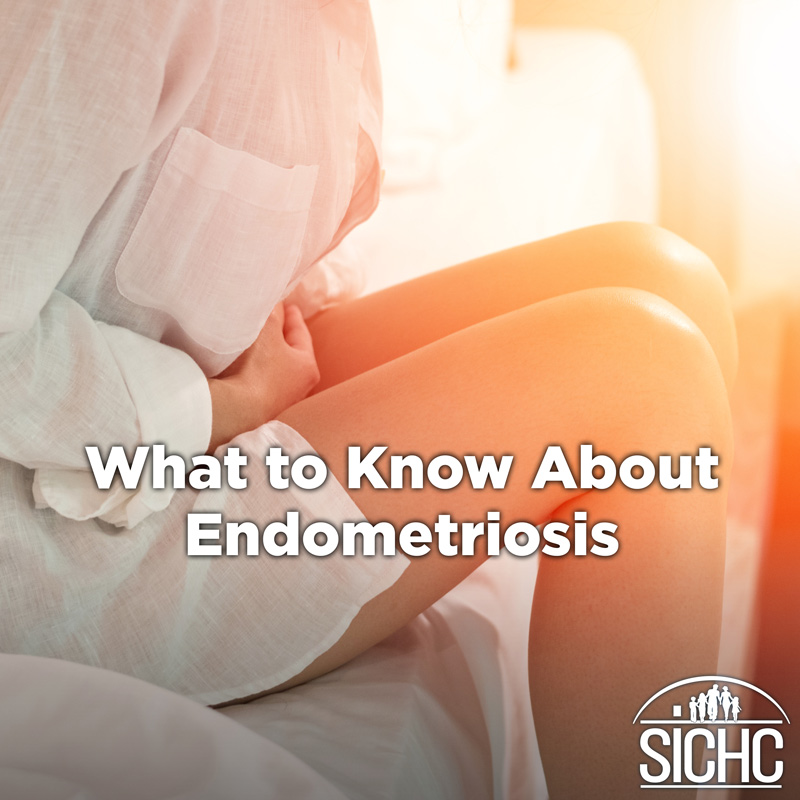What to Know About Endometriosis

by Missy Ray, MSN Family Nurse Practitioner
What is endometriosis?
Endometriosis, also called “endo,” occurs when tissue similar to the lining of the uterus (called the endometrium) is found in other areas in the body. These areas or patches of endometriosis can also be called implants, nodules or lesions.
Most often, endometriosis occurs in the peritoneum, the ovaries, the fallopian tubes, on the outer surfaces of the uterus, bladder, ureters, intestines, and rectum or in the space behind the uterus called the “cul-de-sac.” In rare instances, endometriosis may grow on the lungs or in other parts of the body. Endometriosis causes a chronic inflammatory reaction that may result in scar tissue.
What causes endometriosis?
While no one knows for sure what causes this disease, researchers are looking at several possibilities. These include problems with menstrual period flow, immune system problems, hormones or errors made during other surgery when endometrial tissue is moved by mistake.
You also may be more likely to develop endometriosis if you never had children, had menstrual periods lasting longer then seven days, had shorter menstrual cycles, or have a health problem that interferes with the normal flow of menstrual blood. If a family member had endometriosis, you are most likely at greater risk since there is a genetic component.
While you can’t prevent endometriosis, you can reduce the risk by lowering your estrogen levels, since that hormone is responsible for helping to thicken your uterine lining during your menstrual cycle.
What are the symptoms?
Common symptoms of endometriosis include very heavy periods and chronic pain in the abdomen, lower back, or pelvic areas, especially before and during menstruation or during sexual intercourse. Researchers have discovered that the severity or the location of the pain is not related to the size and location of the lesions, nor is it associated with a woman’s ability to get pregnant.
However, some women with endometriosis may have no symptoms at all, with the condition identified only when they have difficulty conceiving.
How is it diagnosed?
There is no simple test that can be used to diagnose endometriosis. If your SICHC family provider suspects you may have endometriosis, then the first step is usually a physical exam, including a pelvic exam, where your doctor will feel for large cysts or scars behind your uterus.
You may undergo an imaging test—either an ultrasound or a magnetic resonance imaging (MRI)—that will provide pictures of your reproductive organs. However, undergoing a surgical procedure called a laparoscopy is the only way to definitively identify that you have endometriosis. During the procedure, a small amount of tissue may be removed (biopsied) to be tested (diagnostic evaluation).
Download the First Consultation pdf from Endometriosis.org to help you prepare for your visit.
What are the treatment options?
While there is currently no cure for endometriosis, there are treatment options to help deal with the pain and any infertility issues it may have caused. Treatment choices will be based on the severity of your symptoms and the disease itself, your age and your desire to have children.
Treatment options for endometriosis-associated pain include hormone therapy, over-the-counter or prescription pain relievers, and surgical procedures (laparoscopy or laparotomy) to identify and possibly remove endometriosis patches. Hormone therapy may also keep new lesions from forming but generally don’t get rid of any endometriosis tissue already present.
However, not all treatments work well, and the symptoms may occur after medication is stopped or when a period of time has passed after surgery.
Does endometriosis cause infertility?
According to the American College of Obstetricians and Gynecologists, it’s estimated that close to four in 10 women with infertility have endometriosis, either due to inflammation from endometriosis inhibiting the movement of the sperm or egg through the fallopian tubes and uterus or because that inflammation has damaged the sperm or egg.
If the endometriosis is severe, it may have resulted in scar tissue or adhesions blocking the fallopian tubes. Removing endometriosis tissue through surgery may improve fertility.
For more information, visit these websites: Endometriosis Association, Endometriosis Foundation of America and Endometriosis Research Center, download this fact sheet from Office on Women’s Health, or schedule an appointment with SICHC’s Woman’s Health team, or if you prefer, we can recommend you to an OBGYN specialist.
Resources
American College of Obstetricians and Gynecologists
CDC-Women’s Reproductive Health
Eunice Kennedy Shriver National Institute of Child Health and Human Development
- After Hours Nurse
- Behavioral Health
- Bill Pay
- Breast Cancer
- Children
- Children's Health
- Chronic Care
- Community
- Covid-19
- Diabetes
- Doctor Visit
- Eating Well / Nutrition
- Financial Wellness
- Follow My Heart
- Grief
- Health Tips
- Heart Health
- Hypertension
- Kidney Health
- Medical History
- Mens Health
- Mental Health
- Motherhood
- Obstetrics
- Pain Management
- Payment Info
- Pediatric Care
- Pregnancy
- Rural Healthcare
- Schools
- Senior Health
- SICHC Services
- Sleep
- Sports Medicine
- Stroke
- Team Based Care
- Telehealth
- Uncategorized
- Virtual Doctor Visit
- Wellness
- What to Know…
- Womens Health
- Pregnancy and Health Information and Resources
- Healthy Pregnancy – A short guide for mothers-to-be
- Summer fun and eating healthy
- Dangers of Teen Vaping – and What You Can Do
- Four health facts for Father’s Day
